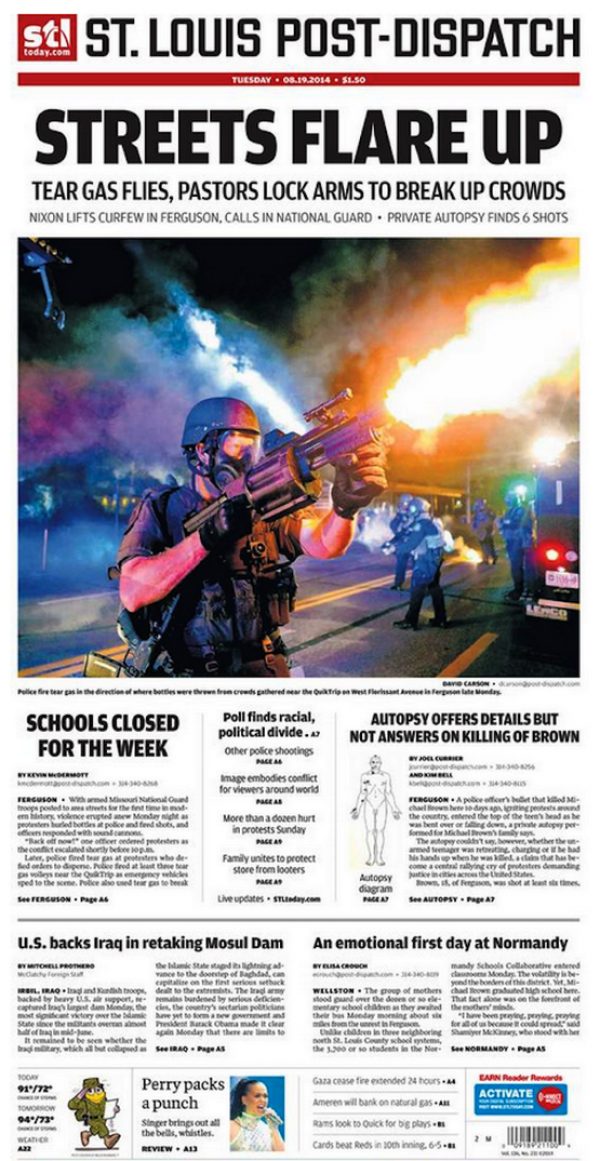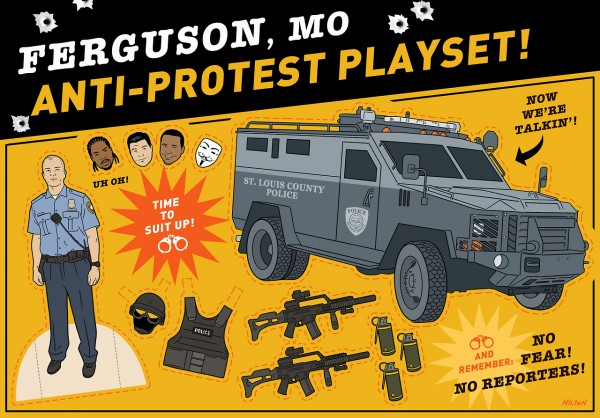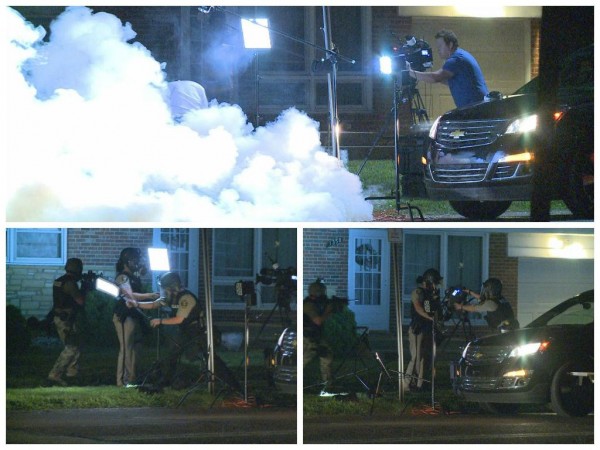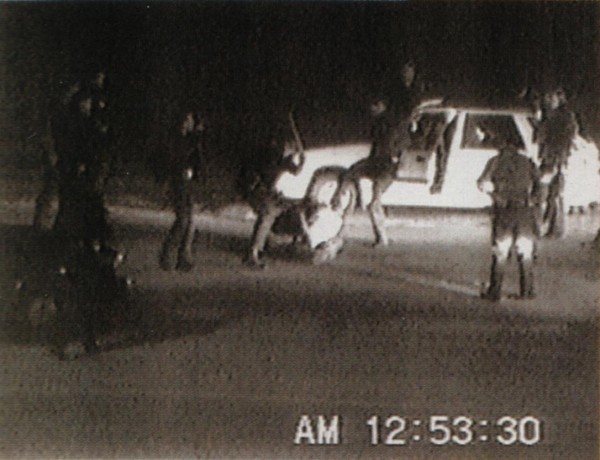
NEWSWEEK: Start with militarization. While this might seem like a “boys with toys” problem—cops playing dress-up as they search for their inner G.I. Joe—it’s really about bad law enforcement tactics. One thing sometimes forgotten is that there are decades of research on policing tactics, and competent officers and their bosses rely on this research to guide them because they are want to maintain law and order, instead of just pretending the movie RoboCop was a documentary. Research shows that militarization rarely works, and usually makes things worse.
Studies also show that police have the power to either lessen the tensions of an angry group of people or goad them into a riot. This conclusion is based on the Elaborated Social Identity Model (ESIM), which is the leading scientific theory on managing a boisterous horde of people. What the ESIM shows is that an angry crowd can be driven to riot if they believe they are being treated unfairly—for example, by being confronted by cops decked out with military weaponry. When police treat a crowd justly and humanely, the chance of an uproar decreases and participants trust law enforcement more, the research shows. […]
For some of the best collections of studies on this topic, check out the Center for Evidence-Based Crime Policy at George Mason University. This group, which is consulted by law enforcement experts around the country, transforms much of the research on police tactics into a data matrix, showing in an easy to comprehend graphic which among more than 100 tactics and techniques have been shown to work, broken down by circumstances involving individuals, groups, small places, neighborhoods and jurisdiction. Not surprisingly, the most effective way to decrease crime and engender public support for law enforcement officers is through what is known as community policing and problem-oriented policing.
These approaches are the opposite of the swoop-and-crush approach taken early on in Ferguson—they entail having cops work closely with the community, become respected contributors to it, engage with both private and public organizations and do a lot of research—know their community. In other words, it’s about making the police an appreciated participant in the daily life, rather than a threatening “other” enthralled with its authority, ego and weaponry. MORE
Artwork by KYLE HILTON
VOX: It looked at first like police in Ferguson, Missouri, were lashing out at journalists only incidentally. Everyone in their path seemed to be at risk of being teargassed, arrested without charge, or having assault rifles pointed at them without warning — so naturally the reporters milling around town were at similar risk. Increasingly, though, it is becoming clear that police in Ferguson are targeting journalists, using intimidation, arbitrary arrests, and physical force. This has a much deeper and more damaging effect than just suppressing media coverage. Arresting and intimidating journalists are inherently political acts, guaranteed by design to generate attention. Much as when it’s done in far-away conflict zones and authoritarian states, it’s about making a statement. It’s about demonstrating, to ordinary citizens even more than to journalists, that police believe they can exercise absolute control over the streets and anyone in them.
That police in Ferguson are targeting journalists so openly and aggressively is an appalling affront to basic media freedoms, but it is far scarier for what it suggests about how the police treat everyone else — and should tell us much about why Ferguson’s residents are so fed up. When police in Ferguson are willing to rough up and arbitrarily arrest a Washington Post reporter just for being in a McDonald’s, you have to wonder how those police treat the local citizens, who don’t have the shield of a press pass. Intimidation of journalists is becoming routine in Ferguson. On Wednesday, police in Ferguson roughed up and arrested Washington Post reporter Wesley Lowery and Ryan Reilly of the Huffington Post for failing to exit a McDonalds. According to Lowery’s Twitter account, the two were “assaulted and arrested” because “officers decided we weren’t leaving McDonalds quickly enough, shouldn’t have been taping them.” They were later released, but the fact of their arrest was enough to show how police would treat journalists in Ferguson.
Since those first arrests, police actions against journalists in Ferguson have escalated in severity and frequency. Getty photographer Scott Olson, who’s been in Ferguson all week, was arrested on Monday and stuffed into the back of a police van for no clearly discernible reason. “He was literally just across the street from the media area. Not a good sign for media access tonight,” Reilly tweeted. CNN’s Don Lemon was broadcasting live from one of the town’s designated protest areas when a police officer began shoving him in an attempt to physically force him to leave the area: An Al Jazeera America TV crew, set up to safely shoot on the sidelines of a recent police deployment, had to abandon their equipment when police fired tear gas at them. After they ran, police walked over and dismantled the set-up, turning over the equipment. [pictured, below]
Reporters have been shouted at by police, had heavy weapons pointed at them, been subjected to military-law style curfews, and been ordered to confine themselves to small, set areas when outdoors. Journalists who leave these corralled zones or venture outside during the curfew — who attempt to walk down a public suburban street in America, in other words — are threatened with arrest. “If you walk about 100 feet from OK’ed press area you find yourself lit up by a spotlight and a squad of police on hair trigger,” MSNBC host Chris Hayes tweeted recently from Ferguson. Later that night, as Hayes’ team filmed the protests, police told them, “Media do not pass us. You’re getting maced next time you pass us.”
On Thursday, the American Civil Liberties Union announced it was suing the town and the county, seeking a court order from a judge telling police that they cannot bar journalists from reporting. On Thursday, the ACLU got what they wanted: a court agreement, signed by the city and the county and the Missouri Highway Patrol chief, stating: “Parties acknowledge and agree that the media and members of the public have a right to record public events without abridgment unless it obstructs the activity or threatens the safety of others, or physically interferes with the ability of law enforcement officers to perform their duties.” Even more astounding than the fact that this was necessary is the fact that it was so quickly ignored. MORE
SLATE: If Holder concludes that there has been a pattern of misconduct by the police—either in the lead-up to Brown’s death or in its aftermath—the president has the ability to force widespread reforms within the department with the help of a law passed in the wake of the Rodney King beating. The provision in question, part of what was officially known as the Violent Crime Control and Law Enforcement Act of 1994, is “one of the most significant” pieces of civil rights legislation passed in the latter part of 20th century, and also one of the most “overlooked,” according to Joe Domanick, the associate director of the John Jay College of Criminal Justice’s Center on Media, Crime, and Justice. The law gives the federal government two options: It can either formally pursue a federal civil rights lawsuit against the Ferguson Police Department by alleging a “pattern and practice” of misconduct or the administration and city officials can enter into what is known as a “consent decree” that would mandate a specific set of reforms that would then be overseen by an independent court-appointed monitor. Faced with the possibility of a costly court battle, most cities have historically taken the path of least resistance and signed on the decree’s dotted lines. Ferguson officials probably wouldn’t buck that trend. MORE



